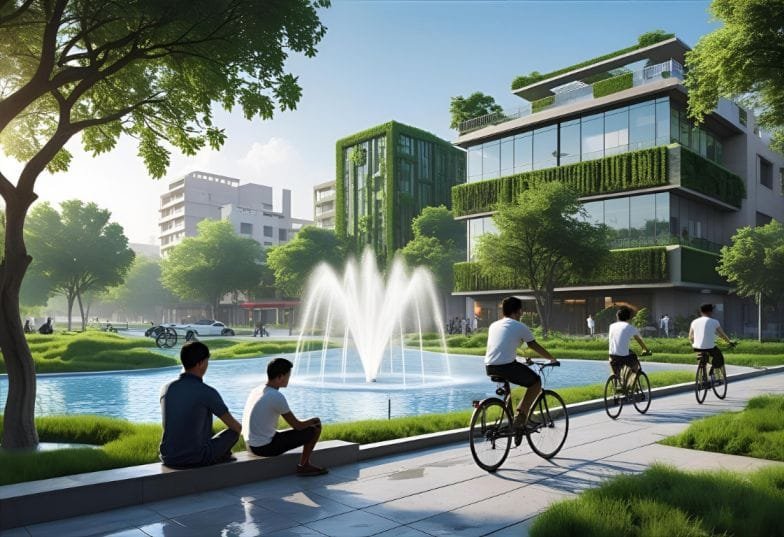Introduction:
Urban cooling solutions in India are no longer optional — they’re essential for surviving rising heat, worsening air quality, and unpredictable urban floods. From nature-based solutions like bioswales and tree belts to scalable green infrastructure such as permeable pavements and rooftop gardens, these strategies are becoming the foundation of climate-resilient urban design.
There was a time when Indian summers meant mangoes and matkas. Today? It’s cracked pavements, boiling rooftops, and roads that vanish under storm surges. And while ACs offer temporary relief, they can’t replace long-term protection. Real safety lies in urban cooling solutions that work with nature — not against it. These approaches are central to initiatives like the C-Cube Climate Centre by NIUA, which supports sustainable city development across India.
Honestly, I never imagined I’d be reading — or writing — about bioswales, sponge cities, or urban heat islands. But one brutal monsoon changed that. The street outside my flat in Delhi flooded three times. The local park? Bone dry by December. It didn’t make sense — until I realized that nature-based solutions aren’t just about looking green — they’re about helping cities survive climate change and function better.
This blog isn’t just for planners or policymakers. It’s for anyone who’s ever asked:
🟢 Can planting more trees cool down my city during heatwaves?
🟢 What can one apartment-dweller even do in a dense urban setup?
🟢 Why do some Indian cities handle floods and heat islands better than others?
In the next sections, I’ll explore 10 India-specific nature-based cooling strategies — from Miyawaki forests in Mumbai to bioswales in Bengaluru and permeable pavements in Pune. These changes are already reshaping our cities, and maybe even your neighborhood.
Table of Contents
How to Start Urban Cooling Projects in Indian Cities
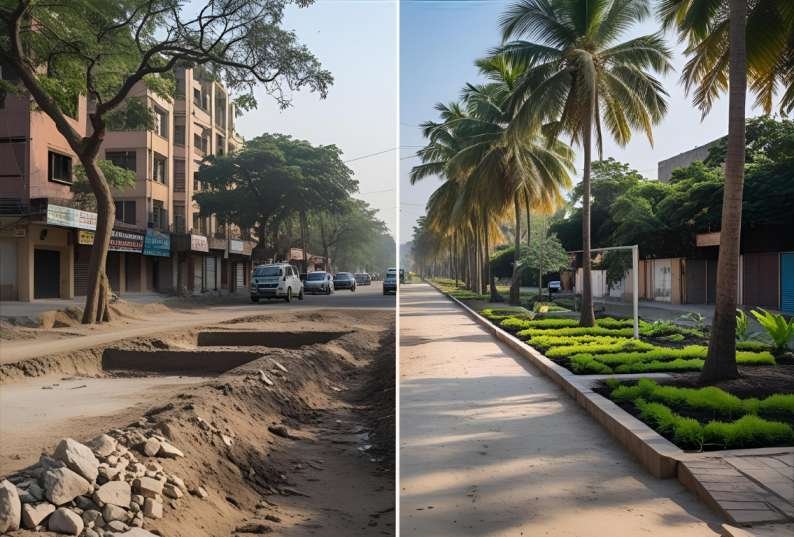
What Are Nature-Based Urban Solutions?
Think of nature not just as decoration, but as infrastructure.
In urban India, nature-based solutions are methods of working with the environment to address modern challenges such as extreme heat, flash floods, poor air quality, and declining water tables. These aren’t expensive high-tech fixes. They’re often low-cost, low-maintenance, and quietly powerful.
Instead of laying more concrete, these solutions utilize plants, soil, water, and trees to manage urban stress — and they’re gaining traction quickly.
“Nature isn’t a luxury in cities. It’s the insulation, drainage, cooling, and healing we forgot to value.”
10 Practical Ideas Already Working in Indian Cities
Here are some of the most effective urban cooling solutions in India — many of which are already transforming neighborhoods quietly across the country.
1. Bio-swales for Flood Control & Climate Resilience in India
- Shallow, plant-lined trenches that slow stormwater — known as bioswales — are being promoted by climate planners and featured in resources like WRI India’s Urban Resilience Toolkit.
- Cities like Chennai and Surat are piloting these in flood-prone areas.
📎 Explore more in our guide to sustainable urban living in India.
2. Miyawaki Forests: Urban Greening for Cooling Indian Cities
- Ultra-dense micro forests grown in small spaces (even parking lots!)
- Miyawaki forests — like those in Bengaluru and Mumbai — are also supported by groups like SayTrees, an NGO working on urban afforestation in India.
💬 “I visited a Miyawaki patch in Gurgaon that was barely 2 years old — and already cooler than the nearby tar road.”
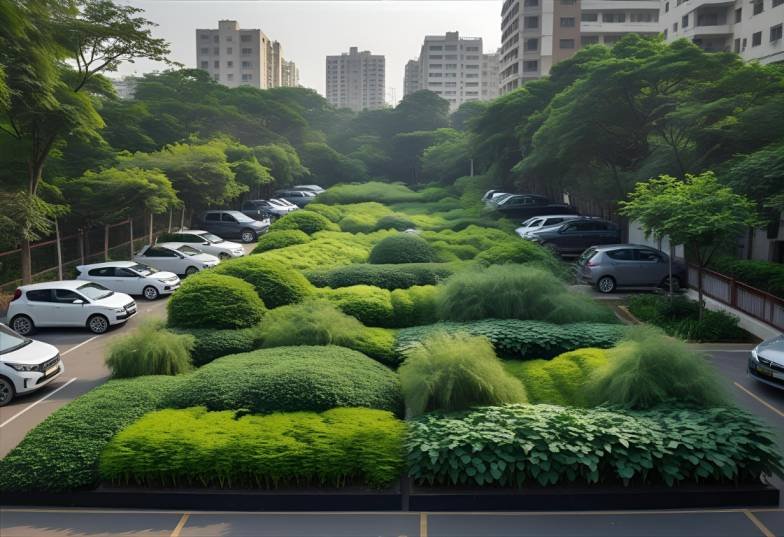
🌿 Case Study: Miyawaki Forest in JP Nagar, Bengaluru
Before plantation (open field, March 2021): avg. afternoon temp = 36.8°C
After 2 years (dense cover, March 2023): avg. temp inside canopy = 33.4°CThat’s a drop of 3.4°C — measured using handheld thermometers during a local citizen-led biodiversity audit. Residents reported cooler walking conditions and an increase in bird activity.
3. Green Roofs in India: Cooling Urban Heat Naturally
- Buildings covered with vegetation that lower inside temperatures and absorb rainwater.
- Pune and Hyderabad offer policy incentives for these.
Mini Case Study: Roof Garden at Gokhale College, Kolkata
- Before installation (May 2022):
Rooftop surface temp = 48°C, indoor ceiling = 41°C- After 9 months of green roofing (Feb 2023):
Rooftop = 35°C, ceiling = 33°CA 13°C drop in roof surface temperature and an 8°C improvement in indoor comfort, without AC — verified by a student-led climate resilience project.
4. Permeable Pavements: Green Infrastructure for Water Absorption
- Instead of regular cement, these allow water to seep into the ground.
- Used in Chandigarh’s eco-sectors and newer campus designs.
5. Restoring Wetlands: Nature-Based Solutions Against Floods
- Restoring marshes or waterbodies to absorb runoff and reduce flood risk.
- Bengaluru’s Jakkur Lake is a great example.
6. Tree Belts: Heatwave Mitigation in Indian Cities
- A row of native trees reduces ambient temperature, blocks dust, and supports biodiversity.
- Delhi’s central verge tree lines are being studied for heat reduction.
7. Rain Gardens: Eco-Friendly Stormwater Management
- Slightly sunken gardens that collect rain runoff from roofs and roads.
- Local colleges in Kochi and Indore have incorporated these into their campus designs.
8. Compost Parks: Cooling Microclimates & Promoting Sustainability
- Small green pockets that recycle wet waste while cooling their microclimate.
- Common in Chennai and Thiruvananthapuram ward-level plans.
Small green pockets that recycle wet waste are not only effective for urban cooling, but also ideal for DIY composting in apartment spaces.
9. Mangroves: Coastal Climate Resilience in India
- Coastal cities like Mumbai rely on mangroves to block storm surges and high tides.
- Losing these = rising floods.
10. Green Campuses: Urban Cooling & Youth Engagement
- Educational institutions are growing trees, vegetables, and hosting eco-clubs.
- My college in Kolkata had a roof garden — we didn’t realize it was cooling classrooms below until someone brought a thermometer.
📊 Comparing Cooling Solutions in India
Here’s a quick comparison of the cost, maintenance, and temperature impact of the top nature-based urban cooling strategies in India.
| Solution | Avg. Cost (₹/sq ft) | Impact (°C Reduction) | Impact (°C Reduction) |
| Miyawaki Forest | 200–500 | Low | 2–3°C |
| Green Roof | 300–800 | Medium | 4–7°C (indoor) |
| Permeable Pavement | 150–400 | Low | 1–2°C (surface) |
| Rain Garden | 100–300 | Low | 1–3°C (surface + air) |
| Compost Park | 80–200 | Low | 1–2°C (localized effect) |
💡 Real Talk: It Doesn’t Take Much
I used to think I needed space or permission to do any of this. But I started with one aloe vera plant outside my window — and it became a conversation starter, a heat absorber, and my tiny vote for better cities.
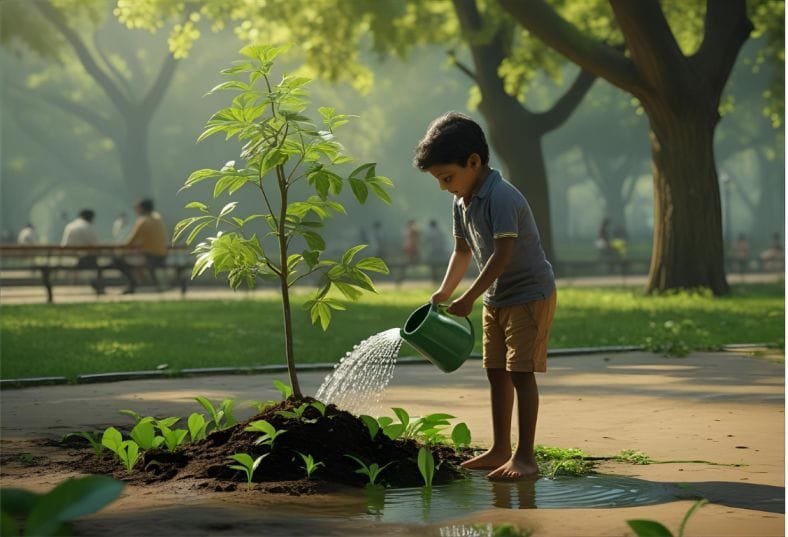
Common Challenges in Indian Cities
🧱 Why Aren’t We Doing More Already?
Suppose these urban cooling solutions are so effective. Why aren’t Indian cities full of bioswales, tree canopies, and sponge pavements already? Green solutions also help address non-point source pollution — a hidden but serious threat in Indian cities.
Here’s the truth: it’s not laziness—it’s layered complexity.
🧩 1. Space Crunch in Overbuilt Cities
Ever looked around your city and thought, “Where could we even plant more trees?”
- Indian cities like Mumbai, Kolkata, and Pune are bursting at the seams.
- Green corridors need land, and land here is a premium battle.
- What gets prioritized? Parking lots or native plants?
💭 Lived Experience: I once pitched a green strip near my apartment in Delhi, and the first question from the RWA was: “Will it reduce our car space?” That killed the idea before it started.
💰 2. Short-Term Thinking in Policy
Long-term nature projects don’t offer “ribbon-cutting” moments.
- Bioswales take years to show impact.
- Restoring a wetland isn’t flashy—it’s slow, layered, and silent.
- Despite their benefits, nature-based approaches often lose out in city budgets. The ClimateSmart Cities program by MoHUA is working to reverse that trend by supporting green infrastructure.
🧠 Micro-action Tip: Join or start a citizen group that tracks green budget allocations in your ward. Transparency brings pressure.
🏗️ 3. Lack of Local Know-How
Many planners or builders still treat green infrastructure as aesthetic, not functional.
- Contractors may not know how to build a swale or layer a rain garden.
- Plants chosen for aesthetics often die within months due to poor planning.
💡 4. Misalignment Between Stakeholders
Urban cooling involves many hands: city officials, citizens, engineers, landscapers, RWAs.
- Often, they don’t even speak the same language.
- Example: A city official plans a pond revival, but local people fear waterlogging.
- Result? Stalemate.
🚧 5. Maintenance Is No One’s Job
One of India’s biggest gaps isn’t installing green spaces—it’s maintaining them.
- Who weeds the bioswale six months later?
- Who keeps the green roof alive when the funding ends?
Alt Text Idea (for image): “Neglected urban bioswale overgrown and clogged after initial installation in India”
Internal Link Suggestion: Link to a section about community-led maintenance or circular city governance (if planned later)
Real-World Examples from Indian Cities
It’s easy to feel like “nothing works here.” But across India, pockets of quiet innovation are transforming how cities deal with heat and floods — using nature, not concrete.
Here are a few that stand out:
🌳 1. Miyawaki Forests in Chennai and Bengaluru
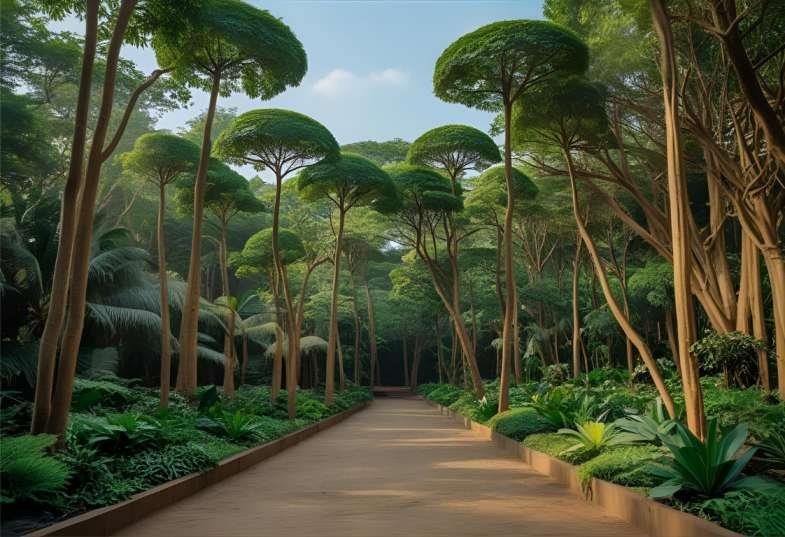
- Chennai’s Kotturpuram forest (started in 2017) now houses over 6,000 trees on half an acre.
- Bengaluru has adopted over 40 Miyawaki-style patches across the BBMP limits.
📌 Why it matters: These mini forests reduce local heat by 2–3°C, absorb carbon, and restore biodiversity in parking-lot-sized spaces.
💧 2. Jakkur Lake, Bengaluru: From Sewage to Sanctuary
Once a dying water body, Jakkur Lake’s success reflects a broader movement, as supported by ICLEI South Asia’s urban nature projects to restore ecological systems in Indian cities.
- Waterbirds returned.
- Groundwater rose.
- Evening walkers returned too.
📌 Why it matters: Natural filtration plus community stewardship = sustainable urban cooling.
🌿 3. Permeable Pavements in Pune
Pilot roads near Baner were resurfaced with porous pavers.
- During monsoons, water seeped through instead of pooling.
- Maintenance was cheaper than constant drain unclogging.
📌 Why it matters: Simple tech + soil = long-term flood and heat relief.
🛤️ 4. Green Metro Stations in Delhi
The Delhi Metro Rail Corporation (DMRC) has added rooftop gardens and vertical green walls in several stations, like Arjan Garh and Shastri Park.
- These reduce interior temperatures by up to 4°C.
- They also absorb noise and improve air quality.
📌 Why it matters: Transit meets climate action — on a roof.
Tailoring Urban Cooling to Your City’s Climate and Culture
Let’s be real: what works in Delhi might flop in Shillong. Urban cooling isn’t one-size-fits-all. It’s more like tailoring a suit — you need to measure your climate, culture, and chaos before cutting the cloth.
🧑🌾 Step 1: Read the Local Landscape
- Is your city flood-prone (like Patna)? Focus on sponge-based strategies.
- Is it an arid heat island (like Jaipur)? Prioritize shade trees and surface reflectors.
- Is greenery discouraged due to dengue fears (like parts of Kolkata)? Consider elevated or water-free cooling methods like vertical gardens or cool roofs.
📌 Tip: Use Google Earth or walk your neighborhood and notice where heat and flooding cluster. Urban clues are everywhere.
🛠️ Step 2: Build with Local Materials & Wisdom
India has centuries of passive cooling design — it’s time to bring it back.
- Red sandstone courtyards in Jaipur
- Jaalis (latticework) in Lucknow
- Stepwells in Gujarat
Pair them with modern tech:
- Traditional jaali + rooftop solar = style + function
- Terracotta planters on balconies = mini urban coolers
👥 Step 3: Include the Invisible Experts
- Local masons, gardeners, women’s groups, RWAs—they all know what won’t work.
- Before designing anything, ask: “Who lives here, and what do they already know?”
📌 Micro-action: Host a “green walk” with your ward or block to gather cooling ideas from residents.
🧠 Step 4: Start Tiny. Stay Consistent.
Big parks sound fancy, but small repeated patches make a bigger difference:
- A 3×3 ft tree pit
- A row of cool-painted roofs
- A wall garden near a public toilet
It’s the cumulative effect that changes city temperatures over time.
The Data Behind Urban Heat, Floods & Resilience (2025 Stats)
Honestly? I used to think greening cities was a “nice to have” — until I read what’s coming. And what’s already here.
🌡️ The Urban Heat Crisis Isn’t Just Numbers — It’s Someone’s Afternoon
In 2023, India endured over 200 days of recorded heatwaves. Delhi scorched past 49°C.
But beyond the stats are stories. According to the India Meteorological Department’s heatwave bulletins, which track temperature spikes across major cities:
- A street vendor in Nagpur fainted on the pavement.
- Schoolchildren in Bhubaneswar were sent home before noon.
- My neighbor’s grandmother, sitting in front of a cooler that barely worked.
Climate change doesn’t feel far away anymore. It’s at our door.
🌧️ Too Much Water, Too Fast
Nature-based flood solutions aren’t “fancy ideas.” They’re survival strategies:
- Mumbai’s 2021 floods caused ₹650 crore in damage in just 3 days.
- Bengaluru saw over 50 mm of rainfall in 1 hour in 2022, swamping tech parks and gated communities alike.
I remember watching from the window as water rushed down our street — not just a puddle, but chest-high currents sweeping past bikes and milk packets. That’s when I realized: drains aren’t enough. Nature is our backup system.
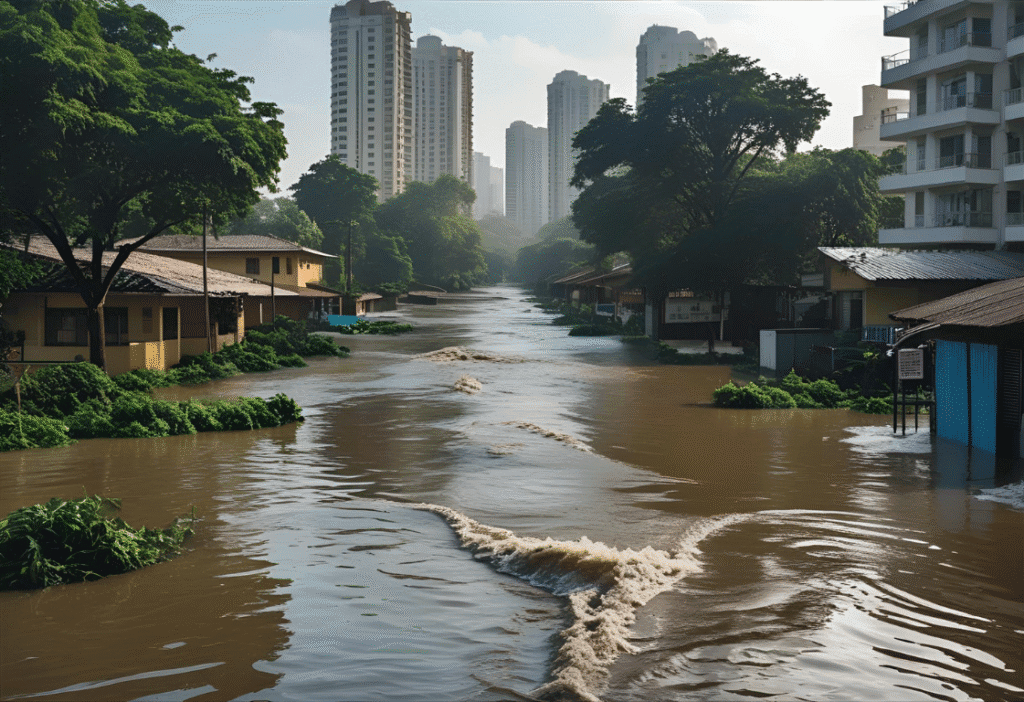
🧬 Cooling Is Health Infrastructure
- WHO notes that extreme heat increases risks of stroke, dehydration, asthma, and even suicide.
- Green cover is linked to lower hospital admissions — especially for cardiac and respiratory diseases.
📌 Why it matters: Trees and wetlands are life-saving infrastructure, not luxuries.
Start Where You Are: Small Cooling Actions That Add Up
Big plans are inspiring. But real change? It starts small — with cracked pavements, sunbaked balconies, and that one neglected patch behind your house.
💡 Micro-Actions with Macro Impact
If you’re wondering “What can I even do?” — here’s how you begin:
- Paint your roof white or light grey — lowers indoor temps by 5–7°C.
- Grow 1–2 native plants in balcony pots — even 1 sq ft of green can cool air and calm nerves.
- Join a tree walk or mapping drive —Citizen groups — like Biome Trust in Bengaluru — offer resources, workshops, and campaigns to help residents participate in greening their neighborhoods.
- Adopt a tree pit — clean, plant, water. One square meter can inspire an entire block.
💬 What I Did
I started with 3 terracotta pots. That’s it. One basil, one lemongrass, and one climber. Within weeks, the balcony felt cooler. My neighbors asked questions. And suddenly, I wasn’t just “planting stuff.” I was part of something bigger.
Why Nature-Based Urban Cooling Solutions Matter in 2025 India
With temperatures rising and floods becoming more frequent, urban India must take nature-based solutions seriously. From tree canopies and green roofs to rain gardens, wetlands, and permeable pavements — these ideas aren’t luxuries anymore. They’re the foundation of sustainable urban planning and essential tools for climate adaptation.
Frequently Asked Questions (FAQs)
What exactly are “urban cooling solutions”?
They’re strategies to reduce extreme heat in cities — using nature, design, or materials (like trees, ponds, green roofs, or white paint).
Are nature-based solutions expensive?
Not always. Many are low-cost or DIY — like planting native trees, using terracotta tiles, or just unpaving small areas.
Which Indian cities are doing this well?
A: Chennai (urban forests), Bengaluru (lake revival), and Pune (permeable pavements) top the list. Delhi’s tree ambulance (a service to rescue stressed trees) is another standout.
I live in a rented flat. Can I still help?
Absolutely! Start with balcony plants, rooftop shade nets, or joining local tree walks. Tiny actions add up.
How do trees help with floods and heat?
They slow rainfall, absorb water, and reduce surface temperatures — a triple win for heatwaves and cloudbursts.
Isn’t this the government’s job?
It is. But citizens, RWAs, and small collectives play a huge role in maintenance, advocacy, and starting local projects.
Where can I learn more or get involved?
Try organizations like SayTrees, Biome (Bangalore), or local urban gardening groups. Or, just ask your neighbor with the greenest terrace.
What is the Climate Smart Cities program?
It’s a MoHUA initiative helping Indian cities plan climate-resilient projects like green roofs, flood control, and low-carbon mobility using data and local solutions.
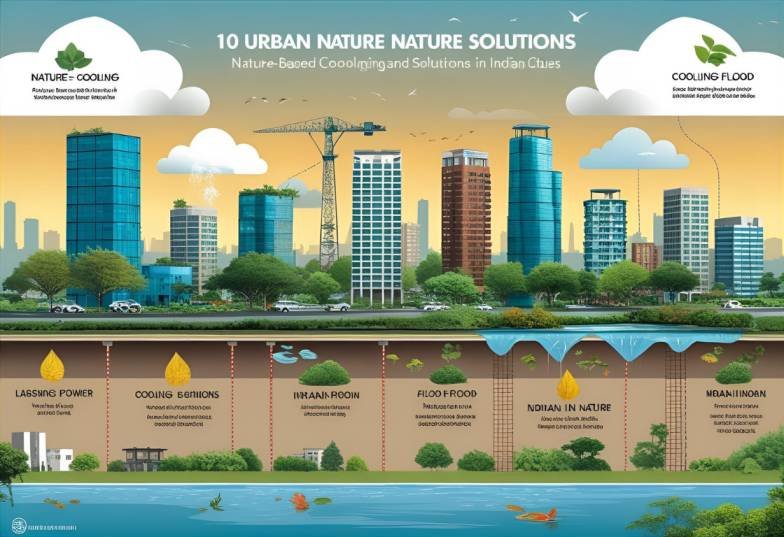
Conclusion: Nature Isn’t a Luxury — It’s Survival
If you live in India, especially in a city vulnerable to heatwaves and flash floods, embracing urban cooling solutions is no longer optional — it’s essential for climate resilience and public health.
Whether it’s installing green infrastructure like rooftop gardens, planting native trees in your neighborhood, or supporting the revival of local wetlands — every step you take supports nature-based solutions that cool cities and protect communities.
Start where you are. A single potted plant, a shaded balcony, or a cared-for tree pit can make a visible difference. The shade you create today might save someone tomorrow.
Author Bio
Soumen Chakraborty is the founder of Ecoplanet (greenglobe25.in), a blog dedicated to sustainable living, urban greening, and zero-waste life in India. Based in Chandrakona, he writes from experience — from growing balcony gardens to advocating for climate-resilient city planning. Follow him on Instagram @greenglobe25 or visit greenglobe25.in to explore more.
💬 “What’s one nature-based change you could try this week? Share it — or better yet, plant it.”
Some of the images in this story were created using AI to help illustrate key concepts more clearly. They’re meant to support learning—not simulate real-world scenes.

